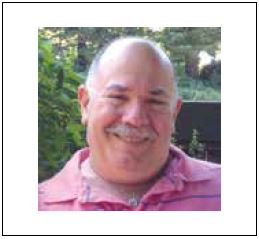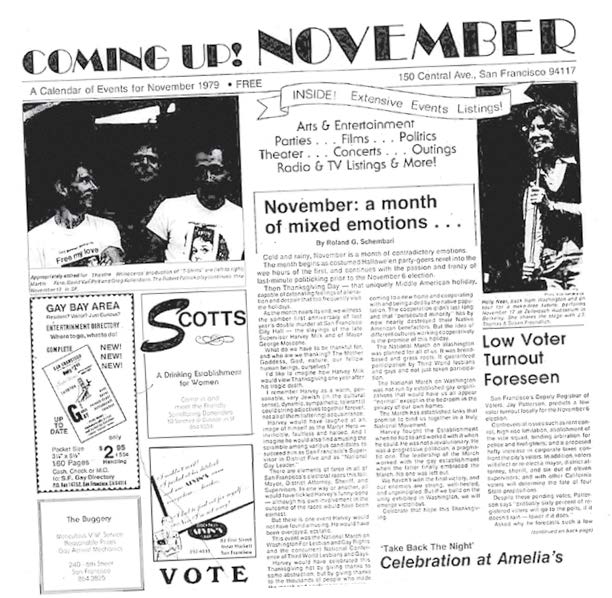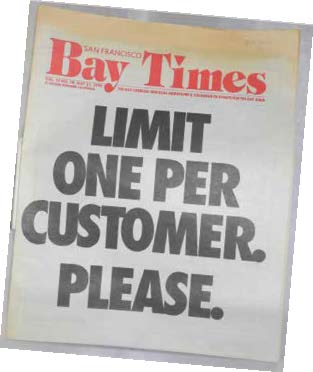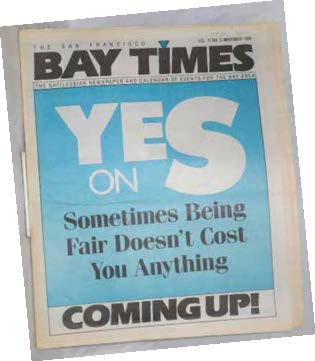 By Dr. Bill Lipsky–
By Dr. Bill Lipsky–
It began with the simplest of ideas: a newspaper “by lesbians and gay men” and for lesbians and gay men, as the masthead of the first issue of the San Francisco Bay Times proclaimed. The goal of founders Roland Schembari and Bill Hartman was not only to bring the community’s diverse people together, but also to “forge links between our movements and those of racial minorities, feminists, rank-and-file labor, environmentalists, the disabled, the old, the young and the poor.”
Schembari, Hartman and their colleagues formed a nonprofit, such that the paper could, as they and their team wrote, be “dedicated to community service” and be “jointly and equally managed” by LGBT men and women. It was the first paper to have this stated mission.
The first issue of the paper, with future San Francisco Supervisor and California State Assemblyman Tom Ammiano on the cover, appeared in May 1978. It included news, commentary, background reporting, a calendar of upcoming events and lists of community resources. Missing, deliberately, were sexist editorializing and graphic advertisements that pandered, or often were offensive, to either men or women.
Even with such gifted staff and contributors as news editor Randy Alfred, features editor Priscilla Alexander, human rights pioneers Phyllis Lyon and Del Martin, early Sisters of Perpetual Indulgence member Sister Mary Boom Boom (Jack Fertig), activists Arthur Evans and Hal Offen, pioneering LGBT historian Allen Berube and photographer Efren Ramirez, among many others, the San Francisco Bay Times initially published only three issues.

“It was ahead of its time, and it was below its budget,” Alfred explained.
Fred Schadick, Schembari’s longtime partner, additionally told the Los Angeles Times in 2000: “They had grandiose plans in the beginning, but they couldn’t pay the bills. They realized they couldn’t start big. But they were committed to producing what they considered to be a responsible and honest publication.”
Despite the early disappointments, Schembari and Hartman believed that they had the right basic formula. They tried again the next year, more modestly, with Coming Up!, a four-page monthly calendar of mostly cultural and political events in the local lesbian and gay communities. Popular from the start, the publication listed arts and entertainment, parties, films, theater, concerts, outings and radio and television listings, although the paper never forgot its progressive roots.
 Kim Corsaro became the paper’s publisher and editor in 1981. With an increasing number of pages, Coming Up! not only reported the news, but also it investigated ongoing stories. In 1984, during the contentious debate about closing the City’s bathhouses—a move that some then believed would help combat the AIDS epidemic—the paper published a pair of memorable, lengthy articles by two local reporters who were asked to research San Francisco’s baths, adult bookstores, theaters and sex clubs for men.
Kim Corsaro became the paper’s publisher and editor in 1981. With an increasing number of pages, Coming Up! not only reported the news, but also it investigated ongoing stories. In 1984, during the contentious debate about closing the City’s bathhouses—a move that some then believed would help combat the AIDS epidemic—the paper published a pair of memorable, lengthy articles by two local reporters who were asked to research San Francisco’s baths, adult bookstores, theaters and sex clubs for men.
Researchers Michael Helquist and Rick Osmon approached their assignment openly and without, as they wrote, the “personal prejudices, political agendas, and uninformed speculation” that influenced many journalists at the time. They did not offer an opinion about the bathhouses or other meeting places, or their patrons, but instead explained what each establishment was doing to confront the community’s crisis. The Helquist/Osmon investigation was so noteworthy that their work was published—again—nearly two decades later, in the peer-reviewed Journal of Homosexuality (Volume 44, 2003, Issue 3–4).
In 1988, the publication changed its name back to the San Francisco Bay Times, keeping “Coming Up” for its community events calendar. During and before this time, the paper became known for its “Personals” section. In the days before the internet and cell phones, LGBTQ people frequently relied upon such print forms of connection. To this day, the publishers hear from couples—still together—who met as a result of the paper. Even “Personals” dating failures could have a silver lining. One talented lesbian, for example, wrote a popular song back in the day called “The Bay Times Personals Blues,” about girlfriends she met, loved and lost through the newspaper.
The San Francisco Bay Times continued to report the news and to follow ongoing stories, but occasionally it became the news as well. In 1992, after newly appointed Chief of Police Richard Hongisto (1936–2004) violated the civil rights of hundreds of demonstrators who were protesting the Rodney King verdicts in Southern California, the paper’s May 7 issue carried an article denouncing his campaign against public dissent. The chief was not pleased.

The paper also showed its utter disdain for Hongisto’s heavy handed and legally questionable tactics with one of its most famous, and some would way notorious, covers in its history: a graphic, unmistakable image showing a police officer—actually Hongisto’s head on the uniformed body of activist Peggy Sue—with an enormous baton pointing upward from his groin. The headline read, “Dick’s Cool New Tool: Martial Law.”
Twenty years earlier, as San Francisco’s sheriff, Hongisto had been regarded as a tremendously progressive civil servant. Elected by what The New York Times described as a “coalition of liberals, radicals, minorities, homosexuals and the young,” he was the first to hire lesbians and gay men into the department and was the city’s first elected official to ride in a Pride parade.
That was then. Now Hongisto apparently was offended by an alternative newspaper disapproving of his heavy hand. Whether or not he ordered the action himself is still controversial, but after the paper had published, several police officers seized some 2,000 copies from newsracks. Hongisto denied telling the officers to take them, but the Police Commission, concluding that at the very least he had suggested they be confiscated, voted unanimously to fire him two weeks later.
In 1994, a U.S. District Court ruled that Hongisto did, in fact, violate the Bay Times‘ first amendment rights. As a result, the paper was awarded $5,600 for financial losses. It also awarded $30,000 to Corsaro for emotional distress. She continued to serve as editor and publisher of the newspaper until mid-2011, when she decided to step down from her longtime roles. Corsaro later became a Field Organizer for then President Barack Obama’s re-election campaign and a blogger for HuffPost.
At that point, Dr. Betty Sullivan and Jennifer Viegas became co-publishers and co-editors of the paper. Both came to their jobs with extensive communications experience. Sullivan had worked for The New York Times, Newsday, USA Today, the San Francisco Chronicle, and other newspapers. In 1996, she founded “Betty’s List,” a popular and successful email announcement service that shares Bay Area news and events with thousands of LGBTQ subscribers. Viegas, in turn, is a founding member of the Discovery Channel news team and is a correspondent for the History Channel and the National Academy of Sciences.
Although the Bay Times and its coverage have evolved during the 40 years since its first issue, the paper strives to remain true to its original principles. As the founders envisioned in 1978, the team still works to provide “reliable, authoritative news, covering the obvious and uncovering the less-than-obvious stories” of interest to the gay, lesbian, bisexual, transgender, and queer communities in the San Francisco Bay Area.
More importantly, it still attempts to create bridges to understanding among the communities’ diverse people and groups who have “differences to share and commonalities to explore.” As Sullivan says, “The need for human connection is timeless and so long as the San Francisco Bay Times facilitates and promotes beneficial connections, it will remain a vital force within our community.”
Whatever the future holds, the Bay Times is intrinsically and integrally woven into the fabric of place and people that is LGBTQ San Francisco.
Bill Lipsky, Ph.D., author of “Gay and Lesbian San Francisco” (2006), is a member of the Rainbow Honor Walk board of directors.
Recent Comments